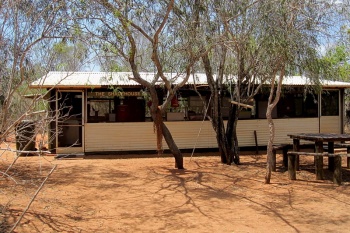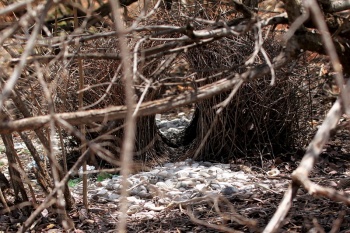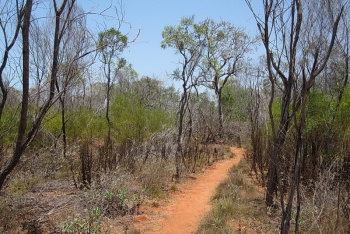Overview
Broome is located on Roebuck Bay in Western Australia's north-west. The weather is tropical, and only two seasons are recognised - The Wet (November to April) when it is hot and humid and often rainy (the "Build Up" - a brief period of opressively high temperatures and humidity during November, before the first rains, could be considered a third season), and The Dry, when it is warm and dry. In September hundreds of thousands of migratory waders end their journeys from Siberia here, to feast on the smorgasboard offered by the most macrobenthically diverse mudflats in the world. Most of these waders leave in March and April, but the young stay in the bay for a few years before commencing their migration to breeding grounds in Asia.
There are various habitats around Broome: tidal mudflats, rocky shorelines, mangroves, grass plains and inland lakes. Because of this, over 300 species can be seen in the area. Due to its position, many vagrant birds also blow in.
Birds
Notable Species
Roebuck Bay is a major staging point for waders before they begin their northward migration to breeding grounds in Asia (mainly Siberia). Thousands of waders stay all year round.
A tour of Roebuck Plains is one of your best bets to see the rare Yellow Chat.
Rarities
Due to its location, Broome is renowned for its vagrants. Famous vagrants include the Grey Wagtail, Chinese Pond Heron, Tibetan Sand Plover, Black-backed Wagtail, Blue and White Flycatcher and Rosy Starling. In April 2009 both Eurasian Curlew and Franklin's Gull were observed multiple times on Roebuck Plains.
Check-list
Birds you can see here include:
Brown Quail, Magpie Goose, Black Swan, Plumed Whistling Duck, Wandering Whistling Duck, Australian Wood Duck, Pink-eared Duck, Grey Teal, Hardhead, Pacific Black Duck, Green Pygmy Goose, Australasian Grebe, Brown Booby, Australasian Darter, Little Black Cormorant, Little Pied Cormorant, Pied Cormorant, Australian Pelican, Lesser Frigatebird, Great Egret, Little Egret, Eastern Reef Egret, White-faced Heron, Nankeen Night Heron, Striated Heron, Royal Spoonbill, Australian White Ibis, Straw-necked Ibis, Glossy Ibis, Black-necked Stork, Brolga, Osprey, Brahminy Kite, Black Kite, Whistling Kite, Little Eagle, Black-breasted Buzzard, Wedge-tailed Eagle, White-bellied Sea Eagle, Spotted Harrier, Swamp Harrier, Black-shouldered Kite, Letter-winged Kite, Collared Sparrowhawk, Brown Goshawk, Nankeen Kestrel, Australian Hobby, Peregrine Falcon, Brown Falcon, Grey Falcon, Australasian Swamphen, Black-tailed Native Hen, Eurasian Coot, Spotless Crake, Baillon's Crake, Australian Spotted Crake, Australian Bustard, Red-backed Buttonquail, Little Buttonquail, Ruddy Turnstone, Pintail Snipe, Latham's Snipe, Swinhoe's Snipe, Australian Painted Snipe, Asian Dowitcher, Bar-tailed Godwit, Black-tailed Godwit, Little Curlew, Whimbrel, Eastern Curlew, Spotted Redshank (vagrant), Common Redshank, Common Greenshank, Nordmann's Greenshank (vagrant), Marsh Sandpiper, Wood Sandpiper, Terek Sandpiper, Common Sandpiper, Sharp-tailed Sandpiper, Pectoral Sandpiper, Curlew Sandpiper, Ruff (vagrant), Red Knot, Great Knot, Grey-tailed Tattler, Sanderling, Red-necked Stint, Long-toed Stint, Broad-billed Sandpiper, Comb-crested Jacana, Bush Stone-curlew, Beach Stone-curlew, Banded Stilt, Black-winged Stilt, Red-necked Avocet, Australian Pratincole, Oriental Pratincole, Pied Oystercatcher, Sooty Oystercatcher, Pacific Golden Plover, Grey Plover, Red-capped Plover, Siberian Sand Plover, Greater Sand Plover, Oriental Plover, Black-fronted Dotterel, Red-kneed Dotterel, Masked Lapwing, Banded Lapwing (vagrant), Silver Gull, Franklin's Gull (vagrant), Black-headed Gull (vagrant), Crested Tern, Lesser Crested Tern, Caspian Tern, Gull-billed Tern, Little Tern, Whiskered Tern, White-winged Black Tern, Flock Bronzewing, Crested Pigeon, Peaceful Dove, Diamond Dove, Bar-shouldered Dove, Red-tailed Black Cockatoo, Little Corella, Cockatiel, Galah, Red-collared Lorikeet, Varied Lorikeet, Red-winged Parrot, Budgerigar, Pallid Cuckoo, Brush Cuckoo, Black-eared Cuckoo, Horsfield's Bronze Cuckoo, Little Bronze Cuckoo, Pheasant Coucal, Barking Owl, Australian Boobook, Tawny Frogmouth, Pacific Swift, Red-backed Kingfisher, Pacific Kingfisher, Sacred Kingfisher, Blue-winged Kookaburra, Rainbow Bee-eater, Dollarbird, Black-tailed Treecreeper, Variegated Fairywren, Red-backed Fairywren, Red-browed Pardalote, Striated Pardalote, Mangrove Gerygone, Dusky Gerygone, White-throated Gerygone, Weebill, Spiny-cheeked Honeyeater, Little Friarbird, White-gaped Honeyeater, Singing Honeyeater, Grey-headed Honeyeater, Yellow-tinted Honeyeater, Brown Honeyeater, Rufous-throated Honeyeater, Golden-backed Honeyeater, White-throated Honeyeater, Banded Honeyeater, Black Honeyeater, Pied Honeyeater, Red-headed Honeyeater, Yellow Chat, Hooded Robin, Kimberley Flycatcher, Jacky-winter, Blue and White Flycatcher (vagrant), Grey-crowned Babbler, Varied Sittella, Mangrove Golden Whistler, White-breasted Whistler, Rufous Whistler, Grey Shrike Thrush, Broad-billed Flycatcher, Paperbark Flycatcher, Grey Fantail, Mangrove Grey Fantail, Northern Fantail, Willie Wagtail, Magpie Lark, White-winged Triller, Black-faced Cuckooshrike, Olive-backed Oriole, White-breasted Woodswallow, Masked Woodswallow, Black-faced Woodswallow, Little Woodswallow, Pied Butcherbird, Australian Magpie, Little Crow, Torresian Crow, Great Bowerbird, Horsfield's Bushlark, Australian Pipit, Red-throated Pipit (vagrant), Yellow Wagtail, Black-backed Wagtail (vagrant), Zebra Finch, Double-barred Finch, Long-tailed Finch, Chestnut-breasted Mannikin, Painted Firetail, Mistletoebird, Barn Swallow, Tree Martin, Fairy Martin, Red-rumped Swallow (vagrant), Clamorous Reed Warbler, Arctic Warbler (vagrant), Golden-headed Cisticola, Rufous Songlark, Brown Songlark, Yellow White-eye
Other Wildlife
Agile Wallaby, Northern Nail-tailed Wallaby, Snubfin Dolphin, Hermit Crab, Flame Fiddler Crab, Ghost Crab, Soldier Crab, Land Crab, Blue-spotted Mudskipper, Mangrove Mudskipper, Bearded Mudskipper, Pop-eyed Mullet, various other fish, dozens of macrobenthic invertebrates, Frill-necked Lizard, Northern Bluetongue, Asian House Gecko, Spotted Dtella, "Gehyra Australis", Black-headed Monitor, Gould's Monitor, King Brown Snake, Orange-naped Snake, Moon Snake, Black-headed Python, Stimpson's Python, Mangrove Snake
Saltwater Crocodiles have been spotted in the Broome area. Mostly around the northern beaches. Take care when swimming and fishing.
Site Information
History and Use
Broome is known as the "Gateway To The Kimberley".
It was originally a pearling town, and still is, although technology has improved greatly and pearls are usually cultured nowadays. Many Japanese and Chinese immigrants moved here to work on the old pearling luggers.
Broome's population booms in the dry season (with most caravan parks overflowing), due to the magnificent weather.
Famous tourist spots are Cable Beach, Ganthueme Point and Chinatown.
Areas of Interest
Northern Roebuck Bay
Various wader viewing areas.
Tattler Rocks - Grey-tailed Tattler, Terek Sandpiper, Ruddy Turnstone.
Wader Beach - Red-necked Stint, Broad-billed Sandpiper, Black-tailed Godwit.
Quarry Beach - Eastern Curlew, Red-capped Plover, Asian Dowitcher.
Boiler Point - Black-winged Stilt, Black-tailed Godwit, Bar-tailed Godwit, Red-necked Avocet, Banded Stilt.
Broome Bird Observatory can provide a mud-map of wader viewing sites along the northern edge of Roebuck Bay.
Broome Bird Observatory
While eating your meals in the shadehouse, be sure to watch the bird baths just outside. The Shadehouse itself acts as a kind of luxury bird hide. Common birds to be seen from here are Brown Goshawk, Great Bowerbird, Long-tailed Finch, Double-barred Finch, Bar-shouldered Dove, Peaceful Dove, Diamond Dove, Crested Pigeon, Rainbow Bee-eater, Little Friarbird, Brown Honeyeater, Singing Honeyeater, Rufous-throated Honeyeater and Torresian Crow.
Observatory grounds look for - Rufous Whistler, Grey Shrike Thrush, Tawny Frogmouth, Variegated Fairywren, Red-backed Fairywren, White-breasted Woodswallow, White-throated Gerygone, Yellow White-eye, Varied Lorikeet, Magpie Lark, Red-winged Parrot.
Crab Creek Mangroves
Look for - Striated Heron, Dusky Gerygone, Broad-billed Flycatcher, Yellow White-eye, White-breasted Whistler, Mangrove Golden Whistler, Mangrove Grey Fantail.
Great wader viewing out back of mangroves.
SAFETY - NEVER visit mangroves/tidal mud flats alone. The mud can get VERY deep and the tides move fast. There is a risk of drowning if you become stuck in the mud during an incoming tide. Walk as fast as you can over patches of deep mud - this reduces the time you have to sink.
Roebuck Plains
Look for - Oriental Plover, Yellow Chat, Australian Bustard, Horsfield's Bushlark, Brown Songlark, Golden-headed Cisticola, Masked Woodswallow, Barn Swallow.
At Tagarana Bore look for - White-winged Triller, Olive-backed Oriole, Yellow-tinted Honeyeater, Mangrove Gerygone, Rainbow Bee-eater.
"Twelve Mile"
Look for - White-throated Honeyeater, Pheasant Coucal.
Broome Township
Look for - White-gaped Honeyeater, Little Curlew, Yellow Wagtail, Masked Lapwing, Golden-backed Honeyeater, Osprey.
Cable Beach - Sanderling.
Broome Port - Australasian Darter, Brown Booby.
Town Beach/Chinatown - Red-headed Honeyeater.
Sewer Works
Look for - Black Kite, Whistling Kite, White-bellied Sea Eagle, Australian Pelican, Black-winged Stilt, Wood Sandpiper, Ruddy Turnstone, Plumed Whistling Duck, Grey Teal.
Lake Eda, Lake Campion and Taylor's Lagoon
Look for - Wood Sandpiper, Long-toed Stint, Australasian Grebe, Red-kneed Dotterel, Black-fronted Dotterel, Magpie Goose, Brolga, Black-necked Stork, Black-breasted Buzzard, Comb-crested Jacana, Australian Pratincole, Whiskered Tern, White-winged Black Tern.
Rosy Starling was seen at Lake Eda in late 2004 - first record for Australia.
Coconut Wells & Waterbank Station/Collins Lagoon
Look for - Black-necked Stork, Green Pygmy Goose, Brolga, Australasian Grebe, Royal Spoonbill, Black Swan.
Willie Creek and Barred Creek
Look for - Dusky Gerygone, Beach Stone-curlew, Eastern Reef Egret.
Access and Facilities
The best place for birdwatchers to stay in Broome is at the Broome Bird Observatory, located on the northern shore of the bay, about 25km out of the town, to the east. If you are bringing your own car you will want a 4WD. The road into the Observatory is sandy and quickly becomes badly corrugated. In the wet season it becomes a muddy river.
The Observatory offers a self-contained chalet, donga bedrooms and unpowered camp sites. The camp kitchen or "Shadehouse" is the meeting place for people staying at the Observatory and a great place to eat your meals while watching various birds and Agile Wallabies at the bird baths just outside. Every night there is a "bird call" where all observations for the day are compiled - you're not obliged to participate, but it's fun and a great way to get an idea of what birds are around.
Activities
- Cannon Netting
- Migration Watch
- Shorebird Disturbance Monitoring
- Surveys
Contact Details
Broome Bird Observatory
PO Box 1313, Broome 6725
Phone: (08)9193 5600 or International 011 61 8 9193 5600
- Email: broome@birdlife.org.au
Gallery
Click on images to see a larger version:
Photo © by HelenB
A Great Bowerbird viewed from the Shadehouse, Broome Bird Observatory, Oct 2009Photo © by HelenB
Three Double-barred Finches viewed from the Shadehouse, Broome Bird Observatory, Oct 2009Photo © by HelenB
Rufous-throated Honeyeater, Broome Bird Observatory, Oct 2009Photo © by HelenB
Little Friarbird, viewed from the Shadehouse, Broome Bird Observatory, Oct 2009Photo © by HelenB
Rainbow Bee-eater seen at the Broome Sewer Works, Oct 2009Photo © by HelenB
Pair of Dollarbirds seen on the drive back to Broome, Oct 2009Photo © by HelenB
Plumed Whistling Ducks seen at the Broome Sewer Works, Oct 2009Photo © by HelenB
Plumed Whistling Duck in flight, Broome Sewer Works, Oct 2009Photo © by HelenB
Red-winged Parrot spotted on the drive back to Broome, Oct 2009Photo © by HelenB
Peaceful Dove, Broome Sewer Works, Oct 2009Photo © by HelenB
Eastern Reef Egret, Roebuck Bay at low tide, Oct 2009Photo © by HelenB
Black-neck Stork, previously known as the Jabiru, Roebuck Bay, Oct 2009
External Links
Recommended Citation
- BirdForum Opus contributors. (2025) Broome. In: BirdForum, the forum for wild birds and birding. Retrieved 25 April 2025 from https://www.birdforum.net/opus/Broome





















